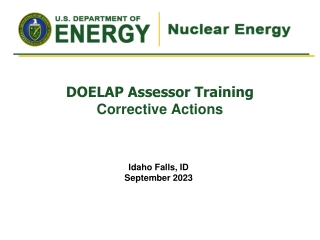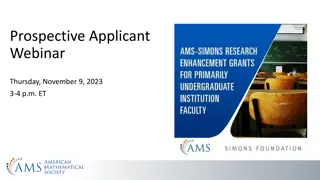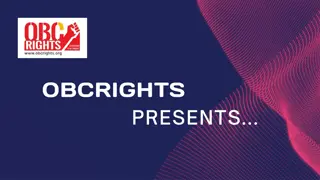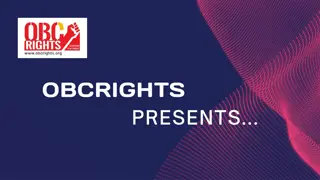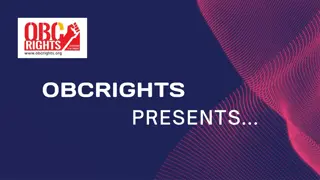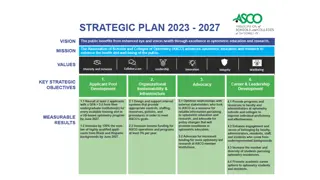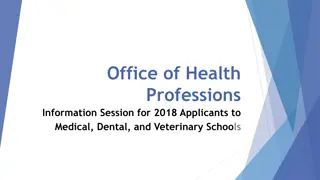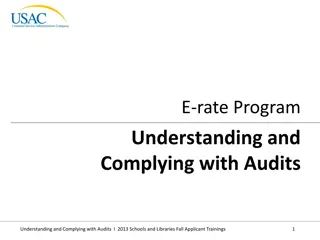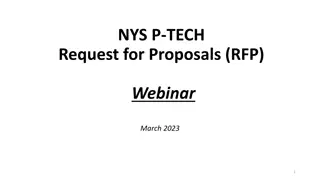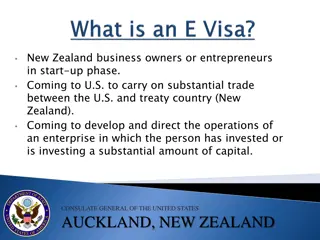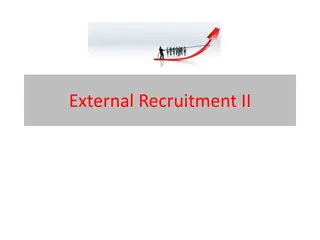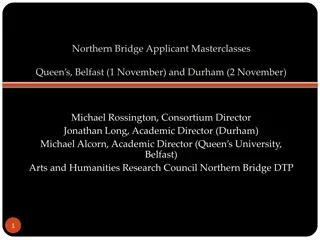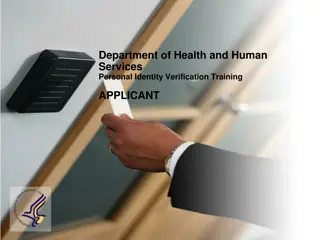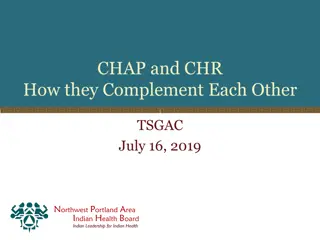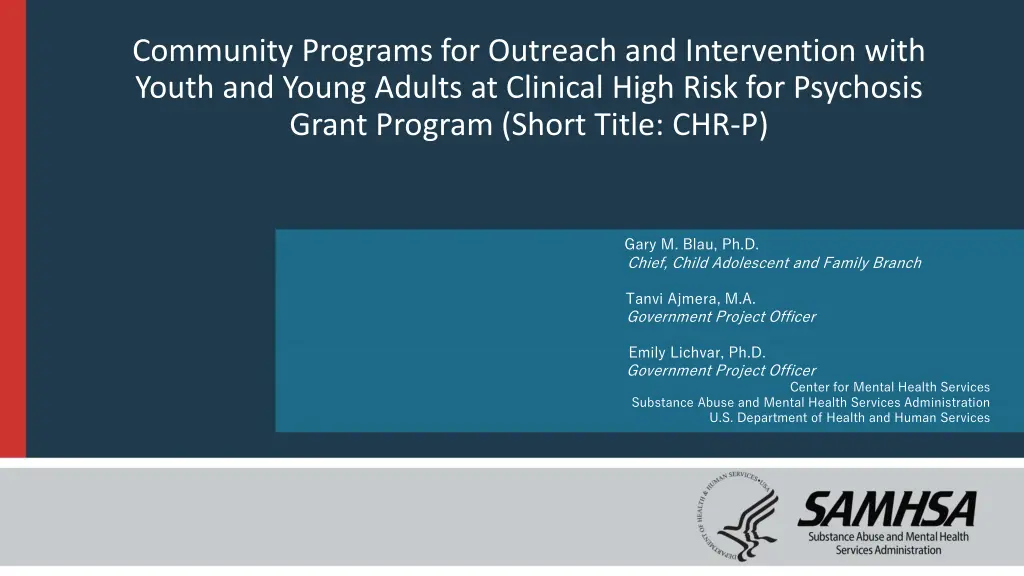
Outreach and Intervention Program for Youth at Clinical High Risk
Learn about the Community Programs for Outreach and Intervention with Youth and Young Adults at Clinical High Risk for Psychosis grant program. Discover the goals, application details, and expectations for this initiative aimed at identifying and supporting individuals at risk for psychosis.
Uploaded on | 2 Views
Download Presentation

Please find below an Image/Link to download the presentation.
The content on the website is provided AS IS for your information and personal use only. It may not be sold, licensed, or shared on other websites without obtaining consent from the author. If you encounter any issues during the download, it is possible that the publisher has removed the file from their server.
You are allowed to download the files provided on this website for personal or commercial use, subject to the condition that they are used lawfully. All files are the property of their respective owners.
The content on the website is provided AS IS for your information and personal use only. It may not be sold, licensed, or shared on other websites without obtaining consent from the author.
E N D
Presentation Transcript
Community Programs for Outreach and Intervention with Youth and Young Adults at Clinical High Risk for Psychosis Grant Program (Short Title: CHR-P) Gary M. Blau, Ph.D. Chief, Child Adolescent and Family Branch Tanvi Ajmera, M.A. Government Project Officer Emily Lichvar, Ph.D. Government Project Officer Center for Mental Health Services Substance Abuse and Mental Health Services Administration U.S. Department of Health and Human Services
Goal of Todays Webinar 1. Increase understanding of the purpose and goals of the Community Programs for Outreach and Intervention with Youth and Young Adults at Clinical High Risk for Psychosis grant program (Short Title: CHR-P) 2. Walk through each element of the Funding Opportunity Announcement (FOA) and provide tips for submitting successful applications 3. Answer questions 2
Application Due Date: June 11, 2018 Estimated No. of Awards: Up to 28 Estimated Award Amount: Up to $400,000 per year Match Required: Yes For Years 1, 2, and 3, you must provide at least $1 for each $3 of federal funds provided by the grant. For Year 4, you must provide at least $1 for each $1 of federal funds provided by the grant Length of Project Period: 4 years Eligible Applicants: Public Entities (States, Counties or Federally recognized Tribes, and/or American Indian/Alaska Native tribal organizations)
Purpose of the CHR-P Grant Program Identify youth and young adults (up to age 25) who are at clinical high risk for psychosis according to the Structured Interview of Psychosis-Risk Syndromes (SIPS) Provide evidence-based interventions to prevent the onset of psychosis. It is expected that this program will: (1) improve symptomatic and behavioral functioning; (2) enable youth and young adults to resume age-appropriate social, academic, and/or vocational activities; (3) delay or prevent the onset of psychosis; (4) minimize the duration of untreated psychosis (DUP) for those who develop psychotic symptoms. 4
Expectations SAMHSA intends that its services programs will result in the delivery of services as soon as possible after award Recipients will be expected to implement a stepped-care* model Recipients must utilize third party and other revenue realized from provision of services to the extent possible and use SAMHSA grant funds only for services to individuals who are not covered by public or commercial health insurance programs, individuals for whom coverage has been formally determined to be unaffordable, or for services that are not sufficiently covered by an individual s health insurance plan. Recipients are also expected to facilitate the health insurance application and enrollment process for eligible uninsured clients. Recipients should also consider other systems from which a potential service recipient may be eligible for services (for example, the Veterans Health Administration or senior services), if appropriate for and desired by that individual to meet his/her needs. Use SAMHSA s Systems of Care principles to ensure the application and program is youth and family guided. Consider needs of returning vets and their families If awarded, develop a Health Disparities Impact Statement-due no later than 60 days after award * Stepped care refers to an approach in which patients start with the least intensive evidence-based treatment. Patients who do not respond adequately to the first line treatment are offered an evidence-based treatment of higher intensity, as clinically indicated. 5
Eligibility Information Eligibility is statutorily limited to the following public entities: State governments and territories (the District of Columbia, the Commonwealth of Puerto Rico, the Northern Mariana Islands, the Virgin Islands, Guam, American Samoa, the Republic of Palau, the Federated States of Micronesia, and the Republic of the Marshall Islands). Governmental units within political subdivisions of a state (e.g., county, city, town). Federally recognized Tribes, and/or American Indian/Alaska Native (AI/AN) tribal organizations (as defined in Section 5304(b) and Section 5304(c) of the Indian Self-Determination and Education Assistance Act).
Eligibility Information (contd.) Evidence Of Experience And Credentials You must meet three additional requirements related to the provision of services: The provider of direct client services (e.g., mental health services, Coordinated Specialty Care Clinics) must be identified in the grant application. Each mental health treatment provider organization must have at least two years of experience (as of the due date of the application) providing relevant services to youth and young adults such as clinical assessments, psychoeducation for individuals and family members, cognitive and behavioral interventions, academic and vocational support, psychopharmacology, and medical management of side effects of medications (e.g.: monitoring for metabolic syndrome with antipsychotic use). Official documents must establish that the organization has provided relevant services for the last two years); and Each mental health treatment provider organization must comply with all applicable local (city, county) and state licensing, accreditation, and certification requirements, as of the due date of the application. 7
Key Personnel Personnel composition for CHR-P must include persons with experience and credentials in clinical service delivery. The key personnel for this program will be the Project Director (PD), Program Coordinator (PC), and Clinical Coordinator (CC). The PD will oversee the program and must be from the applicant agency. The PC will be directly responsible for the service delivery and day-to-day operation, supervision, and management of the program. The CC will be responsible for determining eligibility and will participate in overseeing intervention and evaluation activities. These three positions require prior approval by SAMHSA after a review of staff credentials and job descriptions. Note: Applicants should identify the amount of time (FTE) they will use for the PD, PC and CC as that will be taken into consideration as part of the review. 8
Required Activities (Section V for Review Criteria) Identify an organization, agency, or other qualified entity to provide the required services. Implement a stepped-care model for early psychosis that features lower intensity/lower risk treatments as first-line interventions, with decisions regarding treatment completion, maintenance therapy, or step-up to more intensive care based on objective measures of treatment response. Interventions included in the stepped-care model include: Standardized approaches to CHR-P screening, diagnosis, and psychosis risk assessment; Psychoeducation for individuals and family members; Substance use risk reduction; Cognitive therapy and/or behavioral skills training; Academic, vocational, peer, and family support; and Evidence-based pharmacotherapy, as warranted, for youth and young adults who have co-occurring conditions. Develop and implement training/workforce development activities for providers/staff to implement the stepped-care model. 9
Required Activities Coordinate CHR-P services with other mental health services in the community, including clinics that provide treatment for FEP. (e.g., the Coordinated Specialty Care) programs supported through SAMHSA s Community Mental Health Services Block Grant 10% set-aside for evidence-based treatments for early serious mental illness). Develop and implement primary outreach strategies to engage specialty mental health services (e.g., community mental health clinics, Coordinated Specialty Care clinics, psychiatrists, primary care, social service agencies) to provide education about the CHR-P program and early identification and screening procedures to assure rapid referral to CHR-P care and secondary outreach strategies to organizations and agencies that serve youth and young adults (e.g., schools, faith-based organizations, communities, local settings that serve youth and young adults). Establish bidirectional referral relationships with organizations/agencies that provide Coordinated Specialty Care for FEP to allow for a seamless transition from clinical high risk for psychosis to first episode psychosis care should an individual convert to psychosis; or, to enroll individuals who seek services at Coordinated Specialty Care programs, but do not meet threshold criteria for first episode psychosis. 10
Required Activities (contd.) Provide, coordinate, or link to the following services: Screening, diagnostic, and evaluation services; Outpatient services 24/7 emergency services; Intensive home-based services for youth/young adults and their families when the youth is at imminent risk of out-of-home placement; Respite care; Therapeutic foster care and services in therapeutic foster family homes, individual therapeutic residential homes, or group homes caring for not more than 10 youth; Assisting the individual in making the transition from services received as a child to the services to be received as an adult; Other recovery support services (e.g. supported employment, Coordinated Specialty Care for FEP, family and peer support, primary care services) and focus efforts to provide early intervention for those youth in the clinical risk phase of psychotic illness. Develop mechanisms to promote and sustain youth and family participation (e.g., peer support, development of youth leadership, mentoring programs). Develop and implement an integrated crisis response strategy that includes community-based crisis services and supports to reduce the unnecessary use of inpatient services by youth and young adults at clinical high risk for psychosis. 11
Allowable Activities: These activities are an allowable use of funds but are not required and do not have to be reflected in the Project Narrative. Develop mechanisms to support use of flexible funds to support the individualized needs of youth, young adults, and families to cover costs for services that are not typically reimbursable. Collaborate across child and young adult serving agencies (e.g., substance use, child welfare, criminal and juvenile justice, primary care, education, housing, welfare) and among critical providers and programs to build bridges among 12 partners, including relationships between community and residential treatment settings. Incorporate trauma-related activities into the service system, including screening for trauma, trauma treatment, and taking a trauma-informed approach to care. 12
Using Evidence-Based Practices (EBPs) SAMHSA s services grants are intended to fund services or practices that have a demonstrated evidence base and that are appropriate for the population(s) of focus. Under the CHR-P grant program, recipients will be implementing an applicant selected evidence-based stepped-care treatment protocol model for early psychosis. In Section C of your Project Narrative, you will need to demonstrate your knowledge of evidence-based practices for youth and young adults at clinical high risk for psychosis. Applicants are also encouraged to visit the National Institute of Health website (https://www.nimh.nih.gov/health/topics/schizophrenia/raise/index.shtml) for more information on EBPs related to the prodromal phase of psychosis and first episode of psychosis. 13
Data Collection and Performance Measurement All SAMHSA recipients are required to collect and report certain data so that SAMHSA can meet its obligations under the Government Performance and Results (GPRA) Modernization Act of 2010. Recipients will be required to report on client-level data elements including but not limited to: school status; employment; hospitalization; criminal justice involvement; mental health functioning; adherence to treatment; conversion to psychiatric disorder; and mental health functioning. In addition to client-level outcomes data, recipients are required to report performance on measures such as the following: - The number of individuals contacted through program outreach efforts. - The number of individuals referred for screening to mental health or related services. - The number of individuals receiving mental health or related services after referral. These data are reported using SAMHSA s Performance Accountability and Reporting System (SPARS). Grantees will also be required to participate in a national cross-site evaluation which will examine the effectiveness of this approach. Applicants must submit the Statement of Assurance (refer to Appendix C) attesting that they will actively participate in an evaluation of the CHR-P program and collect and report all requested data. 14
Project Performance Assessment Recipients must periodically review the performance data they report to SAMHSA, assess their progress, and use this information to improve the management of their grant project. Recipients are also required to report on their progress addressing the goals and objectives identified in Section B.1. of the review criteria. The assessment should be designed to help you determine whether you are achieving the goals, objectives, and outcomes you intend to achieve and whether adjustments need to be made to your project. Performance assessments should also be used to determine whether your project is having/will have the intended impact on behavioral health disparities. You will be required to submit an annual report on the progress you have achieved, barriers encountered, and efforts to overcome these barriers. Refer to Section VI.1 for any program specific information on the frequency of reporting and any additional requirements. No more than 10 percent of the total grant award for the budget period may be used for data collection, performance measurement, and performance assessment, e.g., activities required in Sections I-2.2 and 2.3 above. 15
Infrastructure Development Although services grant funds must be used primarily for direct services, SAMHSA recognizes that infrastructure changes may be needed to implement the services or improve their effectiveness. Examples of allowable infrastructure activities: Develop, implement, and evaluate cultural and linguistic competence at the organizational and direct service levels of care. Develop and implement capacity building strategies to provide sustained service delivery to youth, young adults, and their families. Adopt and/or enhance of your computer system, management information system (MIS), electronic health records (EHRs), etc., to document and manage client needs, care process, integration with related support services, and outcomes. Collaborate with existing federal grant programs (e.g., the Community Mental Health Services Block Grant 10% set- aside) to support evidence-based practices that address the needs of youth and young adults with early serious mental illness, including psychosis. Review policies and regulations to improve service delivery, including the incorporation of family-driven and youth- guided care and enhancements to the provision of culturally competent services. Grantees may use up to $25,000 in each grant year for the purchase of Technical Assistance services. 16
Application And Submission Information Applications are due by 11:59 PM (Eastern Time) on June 11, 2018. IMPORTANT APPLICATION INFORMATION:SAMHSA s application procedures have changed. All applicants must register with NIH s eRA Commons in order to submit an application. This process takes up to six weeks. If you believe you are interested in applying for this opportunity, you MUST start the registration process immediately. Do not wait to start this process. If your organization is not registered and you do not have an active eRA Commons PI account by the deadline, the application will not be accepted. No exceptions will be made. Applicants also must register with the System for Award Management (SAM) and Grants.gov (see Appendix A for all registration requirements).
Application And Submission Information 1. REQUIRED APPLICATION COMPONENTS: Budget Information SF-424 Fill out all Sections of the SF-424. In Line #4 (i.e., Applicant Identified), input the Commons Username of the PD/PI. In Line #17 input the following information: (Proposed Project Date: a. Start Date: 9/30/2018; End Date: 9/29/2022). Section A Budget Summary: Use the first row only (Line 1) to report the total federal funds (e) and non-federal funds (f) requested for the first year of your project only. Section B Budget Categories: Use the first column only (Column 1) to report the budget category breakouts (Lines 6a through 6h) and indirect charges (Line 6j) for the total funding requested for the first year of your project only. Section C Leave blank if cost sharing/match is not required for this program. Complete if cost sharing/match is required. Section D Forecasted Cash Needs: Input the total funds requested, broken down by quarter, only for Year 1 of the project period. Use the first row for federal funds and the second row for non-federal funds. Section E Budget Estimates of Federal Funds Needed for Balance of the Project: Input the total funds requested for the out years (e.g., Year 2, Year 3, and Year 4). For example, if you are requesting funds for four years in total, you would input information in columns b, c, and d (i.e., 3 out years). o o o o o A sample budget and justification is included in Appendix L of this document. It is highly recommended that you use this sample budget format. This will expedite review of your application. 18
Application And Submission Information Project Narrative and Supporting Documentation The Project Narrative describes your project. It consists of Sections A through E.No more than five sections can be included in the Project Narrative. Sections A-E together may not be longer than 10 pages. Remember that if your Project Narrative starts on page 5 and ends on page 15, it is 11 pages long, not 10 pages. More detailed instructions for completing each section of the Project Narrative are provided in Section V Application Review Information. The Supporting Documentation section provides additional information necessary for the review of your application. This supporting documentation must be attached to your application using the Other Attachments Form from the Grants.gov application package. Additional instructions for completing these sections and page limitations for Biographical Sketches/Position Descriptions are included in Appendix A: 3.1 Required Application Components, and Appendix G, Biographical Sketches and Position Descriptions. Supporting documentation should be submitted in black and white (no color). 19
Application And Submission Information Budget Justification and Narrative The budget justification and narrative must be submitted as file BNF when you submit your application into Grants.gov. (See Appendix A: 3.1 Required Application Components.) Attachments 1 through 6 Use only the attachments listed below. If your application includes any attachments not required in this document, they will be disregarded. Do not use more than a total of 30 pages for Attachments 1 - 4 combined. Do not use attachments to extend or replace any of the sections of the Project Narrative. Reviewers will not consider them if you do. Please label the attachments as: Attachment 1, Attachment 2, etc. Use the Other Attachments Form from Grants.gov to upload the attachments. Attachment 1: Identification of at least one experienced, licensed mental health treatment provider organization; A list of all direct service provider organizations that have agreed to participate in the proposed project, including the applicant agency, if it is a treatment or prevention service provider organization; Letters of commitment from these direct service provider organizations; including agreement to adhere to treatment protocols and evaluation procedures. Do not include any letters of support. Reviewers will not consider them if you do. 20
Application And Submission Information Attachment 2: Data Collection Instruments/Interview Protocols If you are using standardized data collection instruments/interview protocols, you do not need to include them with the application. Instead, provide a web link to the appropriate instrument/protocol. If the data collection instrument(s) or protocol(s) is/are not standardized, you must include a copy in Attachment 2. Attachment 3: Sample Consent Forms Attachment 4: The Statement of Assurance (provided in Appendix C of this FOA) signed by the authorized representative of the applicant organization identified on the first page (SF-424) of the application, that assures SAMHSA that: (1) the applicant organization and any partnering agencies agree to comply with all data and evaluation requirements set forth by SAMHSA; and (2) all listed providers have met the two-year experience requirement, are appropriately licensed, accredited and certified, and that if the application is within the funding range for an award, the applicant will send the GPO the required documentation within the specified time. Attachment 5: Letter to the SSA (if applicable; see: Intergovernmental Review (E.O. 12372) Requirements). Attachment 6: Non-Federal Match Certification Letter (refer to Section II-2). 21
The Project Narrative describes what you intend to do with your project and includes the Evaluation Criteria in Sections A-E below. Your application will be reviewed and scored according to the quality of your response to the requirements in Sections A-E. In developing the Project Narrative section of your application, use these instructions, which have been tailored to this program. The Project Narrative (Sections A-E) together may be no longer than 10 pages. You must use the five sections/headings listed below in developing your Project Narrative. You must indicate the Section letter and number in your response, i.e., type A-1 , A-2 , before your response to each question. You may not combine two or more questions or refer to another section of the Project Narrative in your response, such as indicating that the response for B.2 is in C.1. Only information included in the appropriate numbered question will be considered by reviewers. Your application will be scored according to how well you address the requirements for each section of the Project Narrative. The number of points after each heading is the maximum number of points a review committee may assign to that section of your Project Narrative. Although scoring weights are not assigned to individual questions, each question is assessed in deriving the overall Section score.
Evaluation Criteria Section A: Population of Focus and Statement of Need (15 points approximately 1 page) Section B: Proposed Implementation Approach (30 points approximately 5 pages) Section C: Evidence-Based Service/Practice (20 points approximately 1 page) Section D: Staff and Organizational Experience (25 points approximately 2 pages) Section E: Data Collection and Performance Measurement (10 points approximately 1 page) Budget Justification, Existing Resources, Other Support (other federal and non-federal sources) 24
Section A: Population of Focus and Statement of Need (15 points approximately 1 page) Identify the geographic catchment area where services will be delivered and how youth and young adults at clinical high risk for psychosis will be impacted by this project. Describe the demographic characteristics of the youth and young adults in terms of race, ethnicity, language, gender, socioeconomic status, and sexual identity. Describe the extent of the problem in the geographic catchment area, including service gaps, and document the extent of the need (i.e., current prevalence rates or incidence data) for the population(s) of focus identified in your response to A.1. Identify the source of the data. Section B: Proposed Implementation Approach (30 points approximately 5 pages) Describe the goals and measurable objectives (refer to Appendix E) of the proposed project and align them with the Statement of Need described in A.2. Identify the outcomes you plan to achieve. State the unduplicated number of youth and young adults at clinical high risk for psychosis you propose to serve annually and over the entire project period with grant funds, how these estimates were derived, and how service numbers will be met. Describe how you will implement the Required Activities as stated in Section I-2. If you plan to use funds for infrastructure development (as stated in Section I-2.4), describe how you will implement these activities. If you do not plan to use funds for infrastructure development, please indicate so in your response. Provide a chart or graph depicting a realistic time line for the entire four years of the project period showing dates, key activities, and responsible staff. These key activities must include the requirements outlined in Section I-2: Expectations. The time line must be part of the Project Narrative. It must not be placed in an attachment.]
Section C: Evidence-Based Service/Practice (20 points approximately 1 page) 1. Discuss your knowledge with and approach to providing evidence-based practices to youth and young adults at clinical high risk for psychosis or experiencing a first episode of psychosis, including your experience with providing the identified services in Section I-2.1 Using Evidence-Based Practices of this FOA. Section D: Staff and Organizational Experience (25 points approximately 2 pages) 1. Describe the experience of your organization with similar projects and/or providing services to youth and young adults at clinical high risk for psychosis and your ability to provide training and supervision to clinical and ancillary staff. Identify other organization(s) that you will collaborate and partner with in the proposed project, including their experience providing services to the population of focus, and their specific roles and responsibilities for this project. Letters of Commitment from each partner must be included Attachment 1 of your application. If you are not partnering with any other organization(s), indicate so in your response
2. Provide a complete list of staff positions for the project, including the Key Personnel (Project Director, Program Coordinator, and Clinical Coordinator) and other significant personnel (i.e., Cognitive Behavioral Therapy Clinician, Family Psychoeducation Clinician, Care Coordinator, Peer Support Specialist, Psychiatrist). Describe the role of each, their level of effort, and qualifications, to include their experience providing services to the population(s) of focus and familiarity with their culture(s) and language(s). 3. Identify the overall staffing and supervisory structure that will be developed and provide an explanation for how this structure will meet the needs of youth and young adults at clinical high risk for psychosis and/or FEP and FOA-related requirements. Section E: Data Collection and Performance Measurement (10 points approximately 1 page) 1. Provide specific information about how you will collect required data for this program, the data sources, and how such data will be utilized to manage, monitor, and ensure continuous quality improvement for the entire project period. Describe your capacity and willingness to adhere to the data collection and evaluation requirements in the FOA.
Budget Justification, Existing Resources, Other Support (other federal and non-federal sources) You must provide a narrative justification of the items included in your proposed budget, as well as a description of existing resources and other support you expect to receive for the proposed project. Other support is defined as funds or resources, whether federal, non-federal or institutional, in direct support of activities through fellowships, gifts, prizes, in-kind contributions, or non-federal means. This should correspond to Item #18 on your SF-424, Estimated Funding. Other sources of funds may be used for unallowable costs, e.g., meals, sporting events, entertainment. An illustration of a budget and narrative justification is included in Appendix L: Sample Budget and Justification. It is highly recommended that you use this sample budget format. Your budget must reflect the funding limitations/restrictions specified in Section IV-3. Specifically identify the items associated with these costs in your budget. The budget justification and narrative must be submitted as a file entitled BNF when you submit your application into Grants.gov.
Application Tip Please make sure you meet the technical requirements or the application will be screened out and not scored Review Eligibility Information and Application and Submission Information Sections (as well as referenced Appendices) carefully Please review the evaluation scoring criteria as that is what reviewers will use to score your application. 29
Application Tip Double check requirements that will cause your application to be screened out for non-compliance Required forms Margin, font and line spacing requirements (for text and tables) Page/character limits - particularly important with electronic submissions 30
Application Tip - Beyond Writing the Narrative Ensure you set aside sufficient time for: Obtaining letters of commitment and MOUs Gathering CVs and collecting/writing job descriptions Editing to get to the character count and/or page limit Scanning all documents into PDFs for electronic submission Completing the federal forms Finalizing an approved budget (especially when match is needed) and writing the budget justification Getting the application through Applicant Agency sign-off Registering for SAMHSA s new grant system (allow 6 weeks) 31
After the Application If funded, a Notice of Award will be emailed directly to the Business Official named in the grant application from SAMHSA Grants Management * No paper copy will be mailed * The date for release of results will be determined by the Office of Grants Management - likely to be mid-September The anticipated start of funding is no later than Sept 30, 2018 32
QUESTIONS? 33
Agency Contacts Program Questions: Emily Lichvar Tanvi Ajmera (240) 276-1859 (240) 276- 0307 Emily.Lichvar@samhsa.hhs.gov Tanvi.Ajmera@samhsa.hhs.gov Questions about grants management and budget issues: eRA Questions: Gwendolyn Simpson 1-866-504-9552. (240)-276-1408 gwendolyn.simpson@samhsa.hhs.gov For more information please visit http://era.nih.gov/ 34
Thank You SAMHSA s mission is to reduce the impact of substance abuse and mental illness on America s communities. www.samhsa.gov 1-877-SAMHSA-7 (1-877-726-4727) 1-800-487-4889 (TDD) 35

